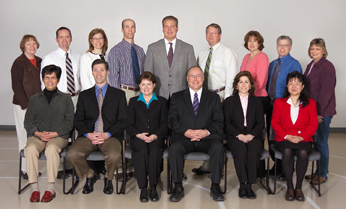 |
The faculty and staff of the Division of Physical Therapy Education are, front row, from left: Grace Johnson, assistant professor; Kyle Meyer, assistant professor and director of clinical education; Pat Hageman, professor and director; Greg Karst, associate professor and associate director; Tammy Roehrs, assistant professor; and Ruiping Xia, assistant professor. Back row, from left: M.A. Ray, program secretary; Michael Rennick, assistant professor; Laura Bilek, assistant professor; Gilbert Willett, associate professor; Wayne Stuberg, professor; Robert Fuchs, assistant professor; Deborah Meyer, research associate; Joseph Norman, associate professor; and Rita Parks-Agnew, administrative assistant. |
Recently, she won the Nebraska Physical Therapy Association’s Achievement in Education award. And on Thursday, the division that she leads was honored with the University-wide Departmental Teaching Award, given to a department within the University of Nebraska that has made unique and significant contributions to teaching.
“It’s been a banner year for our program,” Dr. Hageman said. “The university-wide award is really exciting. It’s a great recognition for all of our faculty members, and we’re thrilled to receive the honor.”
Physical Therapy is the second program in the School of Allied Health Professions to win the award. The Division of Clinical Laboratory Sciences, then called the Division of Medical Technology, was honored in 2002. The UNMC College of Nursing, in 2004, had been the most recent UNMC recipient of the award.
“We’ve known for some time that our physical therapy faculty are among the best in the country, and it’s wonderful that they’re receiving this recognition from the university,” said Mary Haven, associate dean for the School of Allied Health Professions. “And, it’s quite an accomplishment for our school for an Allied Health faculty group to receive this award for the second time in five years. I’m thrilled.”
No strangers to teaching awards, Dr. Hageman’s faculty boasts of four recipients of the School of Allied Health Teacher of the Year Award in the past 5 years. But the recognition for the entire department makes this year’s award special.
Dr. Hageman credits her division’s “esprit de corps” for its success. . “The overall program is only as good as the people in it, and we have great people.” The faculty, staff and students are all committed to the goals of the program and they enjoy the collegial atmosphere of the department.
“We are very cohesive as a group; I think that’s where our strength is,” Dr. Hageman said. “We also are very fortunate to have such a stable faculty who have many years of experience.”
The department’s 14 faculty members have an average length of service of 13 years. Eight of the faculty members are board-certified in specific areas: three in pediatrics, two in orthopaedics, and one apiece in neurology, cardiology and assistive technology. All of the faculty members are active physical therapy practitioners and many are involved in inter-disciplinary research teams.
“We support the overall research mission of the university, especially the clinical research, because we provide the rehabilitation component of medical care,” Dr. Hageman said. “And, our faculty excel in their clinical care; they really do practice what they teach. Good research and clinical care doesn’t automatically translate to good teaching. Our faculty members are dedicated to being excellent teachers and to continuing to improve as teachers. We’ve had a lot of faculty development related to education, and some of our successes – as far as curriculum design and educational models – have been featured in peer-reviewed journals.”
Dr. Hageman is quick to give praise to others for their roles in shaping the division, including the program’s associate director, Greg Karst, Ph.D., and the director of clinical education, Kyle Meyer.
The physical therapy program at UNMC accepted its first class in 1970, offering a bachelor’s degree until 1990. When UNMC implemented its Master of Physical Therapy (MPT) program in 1990, it was among the first 25 percent of U.S. programs to do so. In 2001, the program was among the first five public institutions in the United States to receive approval to offer the Doctor of Physical Therapy (DPT) degree. The first UNMC DPT class graduated in 2004.
Each year, the program accepts 40 students into its three-year curriculum. Most of the students already have bachelor’s degrees, and over the past five years, the average incoming student GPA was 3.70.
In the program, Dr. Hageman said, those students learn to apply evidence-based practices to help patients regain their movement. Most of the program’s graduates practice in Nebraska, and more physical therapists are needed in the state, Dr. Hageman said. Recent estimates indicate that vacancy rates are as high as 8 percent to 12 percent in rural Nebraska, and many openings are available in Omaha and Lincoln.
“A few years ago, the vacancies weren’t as high, but it’s cyclical, and now’s a great time to be looking for a position in physical therapy,” Dr. Hageman said.
So it looks like the program will have ample opportunity to live up to its teaching award, continuing to educate the physical therapy practitioners of tomorrow. And that should keep Dr. Hageman smiling for some time to come.